- Home
- Personal Injury
- PFAS Lawsuit
PFAS Lawsuit
- Upd: December 2, 2025
-
Sarah Miller
- Fact Checked By Our Attorneys
PFAS contamination is becoming a serious issue across the United States. These toxic chemicals, often referred to as “forever chemicals,” are lurking in everyday products and have tainted our water, soil, and even the air we breathe. Prolonged PFAS exposure may cause serious health issues. As contamination is uncovered nationwide, legal claims are growing. If you’ve been affected, you may qualify for compensation.
No Win, No Fee. Let the Best PFAS Attorneys Fight for your Compensation!
Key Takeaways:
PFAS, or per- and polyfluoroalkyl substances, are harmful chemicals found in various products and water sources.
The PFAS lawsuit was initiated because these chemicals have been linked to serious health issues, and manufacturers allegedly failed to warn the public.
People with serious health issues may get up to $500,000. Others may get between $75,000 and $300,000.
PFAS Water Contamination Lawsuit Updates
If you’re looking to keep up with the PFAS water contamination lawsuit, this page has got you covered with straightforward monthly updates and a timeline that’s easy to navigate. Whether it’s new court rulings, settlement discussions, or changes in who’s eligible to file. Everything is laid out in plain language, so you’re always in the loop about what’s going on and what to anticipate next.
In November 2025, PFAS litigation focused heavily on administrative management following a surge in filings, keeping the first personal injury bellwether trial for kidney cancer suspended as the court processed over 1,300 new claims. Consequently, legal efforts shifted toward expert discovery for liver and thyroid cancer cases, with plaintiffs submitting required rebuttal reports by November 21. Although no global settlement was finalized during the month, the court continued to pressure defendants to resolve the growing docket, which now exceeds 15,000 cases, rather than face prolonged litigation.
Legal Claim Assistant is no longer accepting PFAS claims as per September 10.
In October 2025, PFAS litigation activity centered on the postponement of the first personal injury bellwether trial, originally set for October 20. Judge Gergel delayed the trial to manage a massive surge of over 1,300 new claims filed weeks prior.
- October 2: The court selected three additional cases for Tier-2 discovery to prepare for future trials.
- October 14: A new class action was filed against Kimberly-Clark in Connecticut, signaling litigation expanding beyond primary chemical manufacturers to downstream commercial users.
Legal Claim Assistant is no longer accepting PFAS claims as per September 10.
On August 15, 2025, Judge Richard Gergel, who oversees the massive federal PFAS multidistrict litigation (MDL), established a “Filing Facilitation Window.” He mandated that all personal injury claims related to specific PFAS-linked diseases (like kidney, testicular, and liver cancer) should be filed by September 5, 2025. This deadline was later slightly extended to September 10, 2025.
Legal Claim Assistant is no longer accepting PFAS claims as per September 10.
In a significant victory for those advocating for the environment and public health, New Jersey has secured a groundbreaking $2 billion settlement with DuPont, Chemours, and Corteva regarding PFAS contamination, with payments stretched out over 25 years. This historic agreement, the largest of its kind for any single state, will finance cleanup initiatives and establish a new standard for holding polluters responsible. Similar progress is happening in Maryland, where a judge rejected Perdue Farms’ bid to dismiss a PFAS lawsuit, and in Wisconsin, where the Supreme Court has given regulators the authority to demand cleanup even before these chemicals are officially labeled as hazardous. As the legal landscape evolves, there’s an increasing call for individuals impacted by PFAS-related health issues to submit their claims promptly, with settlement talks already in progress for a large group of cases.
July brought major developments in PFAS litigation and science. New studies linked PFAS exposure to type 2 diabetes, cognitive issues in children, and weakened infant immunity. Over 100 contaminated wells were flagged in Minnesota, while South Carolina’s Pocotaligo River was named among the most polluted. DuPont agreed to a $27 million settlement in Hoosick Falls, and Tucson received $4.8 million from a national PFAS settlement. Meanwhile, the judge overseeing thousands of cases urged early resolution before the October bellwether trial. As PFAS-related health concerns grow, more victims are stepping forward to file claims and demand accountability.
June was a significant month for regulatory action. The U.S. Environmental Protection Agency (EPA) announced that it has finalized its rule designating two of the most common PFAS chemicals, PFOA and PFOS, as hazardous substances under the Superfund law. This major regulatory step provides the EPA with enhanced authority to hold polluters financially responsible for cleaning up contaminated sites and to require them to report significant releases of these chemicals. This rule has direct implications for the ongoing litigation, strengthening the legal basis for claims brought by water providers and municipalities seeking cleanup costs.
In May, a key procedural milestone was reached in the PFAS MDL. The judge overseeing the litigation issued an order confirming the selection of the first 25 personal injury cases that will form the initial bellwether discovery pool. These cases were selected from thousands of claims and represent a range of diseases allegedly linked to PFAS exposure, including kidney cancer, testicular cancer, and thyroid disease. The order set deadlines for fact discovery for these specific cases, officially kicking off the trial preparation process for individual harm claims.
April saw continued activity related to the major settlement announced by DuPont, Chemours, and Corteva in March. The court granted preliminary approval to the $1.185 billion settlement fund, which initiated the formal notification period for eligible public water systems. This allowed water providers across the country to begin evaluating the terms of the settlement and decide whether to participate or opt out to pursue their own individual lawsuits. Legal analysts noted this was a crucial step in finalizing one of the largest resolutions in the litigation to date.
March brought some noteworthy developments in the legal landscape. DuPont, Chemours, and Corteva revealed a new settlement, separate from their earlier agreements, totaling around $1.185 billion to tackle PFAS-related drinking water claims for a specific group of public water systems. This came on the heels of their previous significant settlement and aimed to cover a broader range of water contamination issues. This substantial settlement marks an important step, highlighting a trend of large-scale resolutions by the main defendants involved in the litigation.
In February, the spotlight turned to the individual personal injury claims that are part of the larger PFAS litigation. Attorneys for both the plaintiffs and defendants came together to propose a plan for picking bellwether cases. These test cases are crucial because their outcomes can give us a glimpse into how similar future cases might unfold, often leading to broader settlements. The selection process aimed to ensure a diverse representation of the various types of injuries being claimed, including kidney cancer, testicular cancer, and thyroid disease.
January brought a wave of activity in the ongoing national PFAS litigation. One of the key highlights was the first Case Management Order of the year in the multidistrict litigation (MDL) targeting manufacturers. This order set up a fresh leadership structure for the plaintiffs’ legal teams, marking a new chapter in their coordinated legal efforts. On top of that, individuals and water providers continued to file new lawsuits, further swelling the number of cases being handled in the MDL based in South Carolina.
In December 2024, the PFAS litigation saga continued to grow as the multidistrict litigation (MDL) entered its sixth year. More lawsuits were piled on, showcasing the expanding nature of this legal battle. In a related twist, the EPA moved to dismiss a lawsuit against Synagro, claiming it has the authority to regulate toxic chemicals found in sewage sludge. At the same time, the MDL judge gave the green light for Arkema to provide additional discovery and approved a new process for gathering facts on recent cases. These developments indicate a strong momentum and a determined effort to uncover the full scope of PFAS-related harm and liability.
In November 2024, there were significant strides in the legal and regulatory landscape surrounding PFAS. In the multidistrict litigation (MDL), plaintiffs sought to include Arkema, Inc. as a defendant, while new lawsuits were initiated against AGC Chemicals. A former scientist from 3M stepped forward, alleging that the company had been aware of the dangers posed by PFAS for decades. On the regulatory front, the EPA published a report showcasing substantial progress in cleanup efforts, bolstered by the Bipartisan Infrastructure Law. Additionally, a final fairness hearing took place regarding settlements for water providers, with both agreements receiving full approval from the court—marking a positive step for communities affected by PFAS contamination.
In October 2024, there was significant movement in PFAS litigation. A hefty $730 million settlement was reached with Kidde-Fenwal, stemming from claims that their firefighting foam products had contaminated water with harmful PFAS chemicals. This deal stands out as one of the largest settlements to date concerning AFFF contamination. At the same time, the multidistrict litigation (MDL) in the Federal District of South Carolina continued to expand, with new cases being added regularly. Updated plaintiff profile forms were also released, signaling progress toward potential settlements. These developments point to a growing sense of accountability for PFAS manufacturers and an increasing momentum for those seeking compensation for the damages caused by PFAS-related issues.
In September 2024, a resident of Texas took legal action, claiming that their drinking water was tainted with PFAS. This lawsuit is just one piece of the larger puzzle in the ongoing fight across the nation against the manufacturers of these so-called “forever chemicals.”
In August 2024, the landscape of PFAS litigation and investigations continued to grow. The 7th Circuit Court decided that a lawsuit against 3M would remain in state court, while Oppermann Webbing addressed allegations in the ongoing multidistrict litigation. The first phase of the settlement process between 3M and DuPont wrapped up, with the second phase anticipated to pick up speed. Appleton’s Utilities Committee debated whether to opt out of the current PFAS class actions to keep their legal options flexible. A resident from Texas took legal action over contaminated drinking water, and investigations kicked off at the Mohawk and Shaw sites. In the meantime, a new study delved into PFAS sources in Airway Heights, contributing to the mounting scientific evidence.
In July 2024, the legal battles surrounding PFAS were still going strong. Business groups were pushing back against the EPA’s decision to classify two types of PFAS as hazardous under CERCLA, trying to dodge any cleanup responsibilities. A report from the GAO raised concerns that the Department of Defense might not meet its deadline to phase out PFAS-based firefighting foam. Meanwhile, Maryland and South Carolina were advocating to keep PFAS lawsuits within state courts. On another front, BASF settled for $4 million, while the deadline for 3M and DuPont’s Phase 1 settlement was extended, allowing local governments more time to get involved. The struggle over PFAS contamination and accountability is unfolding on many levels.
In June 2024, there were significant developments in PFAS litigation and regulation. Two major national water utility groups took the EPA to court over its new PFAS limits, arguing that the rules aren’t grounded in the best science and aren’t cost-effective for households. At the same time, firefighters in Connecticut banded together to file a lawsuit against 3M and others, claiming that PFAS in their protective gear has led to serious health issues. Even with some recent settlements, PFAS lawsuits are on the rise across the country. Several states are now advocating for tougher regulations, and new investigations are backing up the health concerns linked to these toxic “forever chemicals.” As we head into late 2024, the legal and regulatory pressure surrounding PFAS remains intense.
The largest PFAS class action, MDL No. 2873, is still ongoing, with claims related to environmental damage and cancer cases tied to PFAS-laden firefighting foam. BASF has stepped up with a $315 million settlement for public water suppliers, making it the fourth settlement in this significant lawsuit. Judge Gergel has laid out a schedule for several PFAS lawsuits, particularly concentrating on kidney and testicular cancer cases, and plaintiffs need to reveal their expert witnesses by November 15, 2024. On top of that, a $750 million settlement has been reached with Tyco for public water suppliers, with bellwether trials planned to tackle specific cancers associated with PFAS exposure.
The DOJ has shed light on the EPA’s approach to enforcing PFAS regulations, focusing on major polluters while leaving out farmers, municipal landfills, and fire departments. The EPA has classified PFOA and PFOS as hazardous substances, which means they now require notifications about contamination and the implementation of safety measures. In a significant move, Orange County has launched a major lawsuit over PFAS-related water contamination, marking the first case under the new EPA guidelines. Additionally, the EPA has established the first national standard for PFAS in drinking water, which is expected to trigger even more lawsuits. Tyco Fire Products has reached a $750 million settlement, contributing to the staggering $13.7 billion already settled by Dupont and 3M. Judge Gergel has approved a multi-billion dollar settlement, with 3M’s payments set to begin in the summer of 2024, specifically addressing PFAS-related health issues like kidney and testicular cancer, thyroid disease, and ulcerative colitis.
Massachusetts has issued a warning against purchasing water from Simpson Spring Company due to concerns over PFAS contamination, and legal actions are anticipated. Meanwhile, a federal court in California has dismissed a PFAS class action lawsuit against Edgewell Personal Care, citing a lack of specific allegations. In Connecticut, a new class action has emerged, claiming that Kimberly Clark has contaminated both land and water with PFAS chemicals. On a broader scale, the UN is calling for accountability from DuPont and Chemours for their role in releasing PFAS into U.S. water supplies, which has led to serious health problems.
A class action lawsuit regarding PFAS has been certified in New Hampshire, claiming that Saint-Gobain has polluted the community with these harmful chemicals. Many PFAS lawsuits draw on the Leach case, which established a connection between PFAS exposure and various cancers and health issues. Plaintiffs are pushing for new injuries to be included in the settlements. Judge Gergel recently approved a massive $1.185 billion settlement with Dupont, and a similar $12.5 billion settlement with 3M is expected to follow. The EPA has proposed adding nine PFAS chemicals to its list of hazardous substances, acknowledging their cancer-causing potential. Additionally, Judge Gergel held a hearing regarding the 3M settlement, which will allow public water systems that have tested positive for PFAS to seek damages.
Connecticut has taken a stand by filing two lawsuits against chemical companies for their role in contaminating water and natural resources with PFAS. Recently, a federal court dismissed a class action lawsuit related to PFAS, citing the need for more specific allegations against the defendants. Meanwhile, King Law is stepping in to represent Hoosick Falls, NY, in the ongoing PFAS class action. Good news is on the horizon as the lawsuit approaches a settlement for public water systems, with final approval hearings set for February 2024.
The WHO has confirmed that PFAS chemicals are linked to cancer, including testicular and kidney cancer. Judge Gergel described the $13 billion PFAS settlement for municipalities as historic, with final approval anticipated soon. The PFAS lawsuit is moving forward in three main areas: claims related to contaminated water, personal injury claims, and land contamination claims, with settlements currently in progress.
A final fairness hearing regarding the PFAS settlement with 3M and Dupont is set for December 2023. This settlement has the potential to deliver more than $13.6 billion to water providers.
he PFAS lawsuit is focusing on personal injury claims that involve serious health issues like thyroid disease, testicular cancer, kidney cancer, ulcerative colitis, and pre-eclampsia.
A staggering 15,000 claims have been lodged against Dupont and 3M due to health issues linked to PFAS. So far, these companies have shelled out over $11.5 billion in damages, and it looks like even more is on the horizon.

What Are PFAS and Why Are They Dangerous?
PFAS, which stands for per and polyfluoroalkyl substances, are a group of man-made synthetic chemicals found in countless everyday items because of their ability to repel water and stains. While these substances are built to last, that durability is also what makes them a concern. Many specific PFAS chemicals don’t easily break down in the environment or in our bodies, earning them the nickname “forever chemicals.”
Among the most studied toxic PFAS are PFOA, PFOS, and four other related compounds—collectively known as the six PFAS. These hazardous chemicals are deemed due to their association with serious health issues like cancer, hormone disruption, and damage to the immune system.
For many years, chemical manufacturers and large companies continued to produce and sell products containing PFAS, even as evidence of their dangers mounted. The outcome? A widespread contamination of our water, soil, and air, which poses a significant risk to public health.
“PFAS are called ‘forever chemicals’ for a reason—designed to last, but now linked to cancer, immune damage, and widespread pollution of our water, soil, and air.”
PFAS Explained in Simple Terms
PFAS, or per- and polyfluoroalkyl substances, are a group of synthetic chemicals that pop up in a lot of everyday products, such as nonstick cookware, food wrappers, and water-resistant clothing. These PFAS compounds were designed to withstand heat, oil, water, and stains. While the term PFAS chemical might sound a bit technical, it really just refers to a variety of related PFAS substances that help make products more durable.
In many instances, companies intentionally added PFAS to their products to enhance performance, often without fully understanding the potential long-term consequences.
It’s crucial to grasp what PFAS are and why they’re significant because they can linger in the environment—and in our bodies—for years, potentially posing health risks over time.
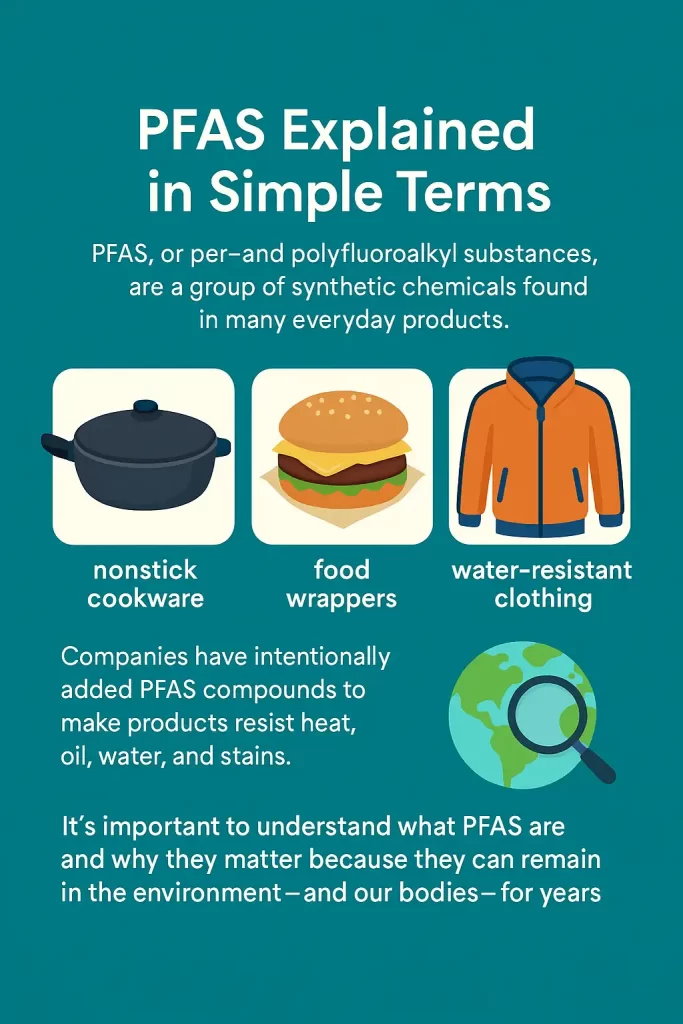
Where PFAS Are Commonly Found (Products, Water, Soil, Air)
PFAS are found in far more places than many people realize. These chemicals exist not just in water, but also in everyday items like food packaging, non-stick cookware, and firefighting foam. In fact, many products contained PFAS for years—often without consumers knowing. Today, we know that PFAS-containing products can release these chemicals into the environment, where they accumulate in surface water, soil, and even contaminated groundwater.
Testing by the Environmental Protection Agency and other researchers has shown elevated PFAS concentrations in drinking water supplies across the U.S. But it doesn’t stop there. Bottled beverages like Topo Chico have been flagged for PFAS contamination in independent tests. Recent testing has found PFAS in drinking water, but also in sparkling water, raising concerns about what’s in your favorite drinks. Even synthetic fabrics such as nylon may contain PFAS, especially in water-resistant clothing and gear.
Whether it’s cookware, clothing, or your tap water, PFAS products are all around us. Understanding where exposure can happen is key to reducing your risk and demanding safer alternatives.
Why PFAS Are Called “Forever Chemicals”
PFAS are often called “forever chemicals” because they don’t break down naturally in the environment. Substances like PFOS can persist in water and soil for decades, spreading through groundwater, rivers, and even the air. Once these chemicals enter the human body, they can also stay there for years.
Because of their strong chemical structure, it’s extremely difficult to eliminate PFAS or remove PFAS completely from the environment or water supplies. This long-lasting presence is what makes them so concerning—and why scientists, regulators, and communities are pushing for stronger action to control and clean up these harmful substances.
“PFAS don’t go away—they build up in water, soil, and our bodies for decades, making cleanup urgent and accountability essential.”
How to Reduce PFAS Exposure at Home
Reducing exposure to PFAS at home starts with understanding where these chemicals might be hiding. Everyday products that contain PFAS include nonstick cookware, waterproof clothing, food packaging, and even cosmetics. Such as:
One of the biggest sources of exposure is drinking water. But how much PFAS is in your tap water can vary. To help, we’ve written about PFAS treatment technologies that can reduce exposure using home filtration systems.
Carbon filters are a common method to remove PFAS, while Reverse osmosis is one of the most effective ways to remove PFAS from water. You can check these filters too:
Because current efforts to regulate PFAS are still evolving, it’s smart to take steps at home. We’ve also written about PFAS-free products that can help lower your risk. Like:
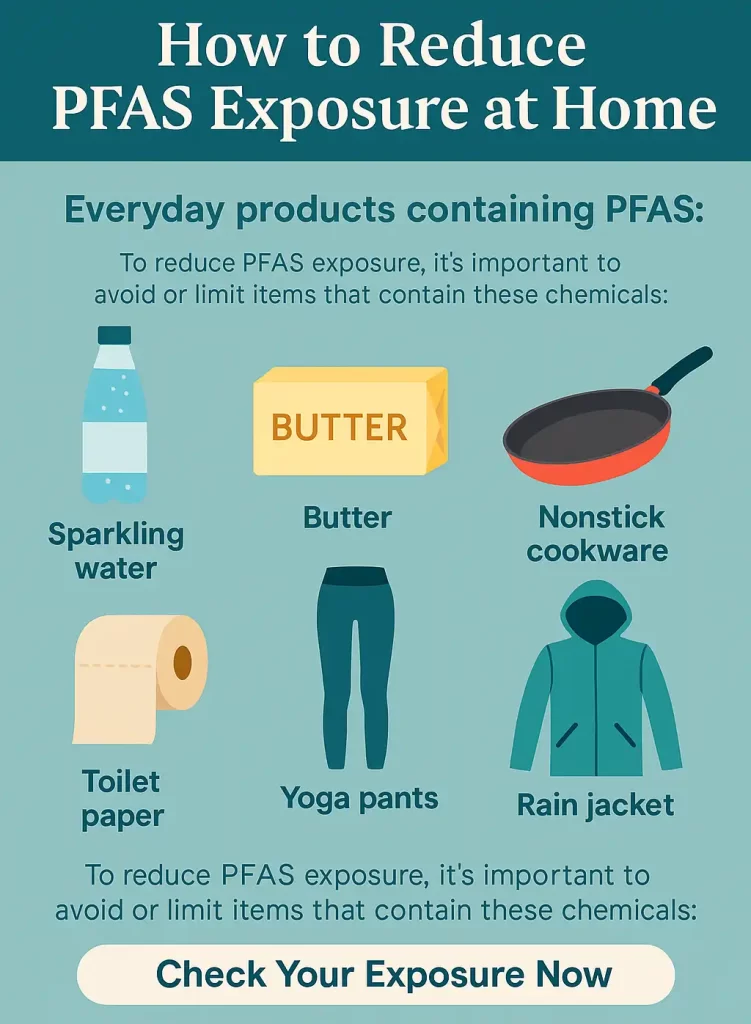
PFAS Exposure and Associated Health Risks
PFAS exposure has been linked to a growing list of health concerns. When people are exposed to PFAS—often through drinking water, food, or household products—these chemicals can build up in the human body over time. Because they don’t break down easily, even low levels of exposure may lead to significant harm.
Studies have uncovered a wide range of PFAS health effects, from cancer and hormonal disruption to immune system complications. Ongoing pfas pollution is not just an environmental issue—it’s directly harming public health, with an increased risk of adverse health conditions tied to long-term contact. The health impacts of PFAS are still being studied, but the evidence continues to grow.
“Even low-level PFAS exposure can build up in the body and lead to serious health risks—this is more than pollution; it’s a public health crisis.”
Cancers Linked to PFAS (Kidney, Testicular, Liver, etc.)
Research has shown a connection between PFAS exposure and certain cancers, particularly Kidney cancer and Testicular cancer. These two types have been most consistently linked to long-term contact with PFAS in drinking water or the environment.
Scientists believe that once PFAS enter the body, they may interfere with normal cell function and increase the risk of tumor growth over time. While the exact mechanism is still being studied, the evidence is strong enough to raise serious public health concerns.
Ongoing research continues to investigate the broader link between PFAS and cancer, including several rare and aggressive forms.
These are other cancers linked to PFAS:
Ulcerative Colitis and Other Digestive Issues
Emerging research continues to strengthen the link between PFAS and ulcerative colitis, especially in individuals with long-term exposure through drinking water. PFAS chemicals may cause inflammation in the digestive tract, leading to serious and sometimes chronic health problems.
Even popular products like Prime have faced scrutiny in a Prime drink lawsuit for potential health risks tied to PFAS contamination. While more studies are underway, early findings suggest that exposure to these chemicals may disrupt gut health, raising concerns for people with conditions like colitis or other inflammatory digestive disorders.
“PFAS exposure may inflame the gut and increase the risk of ulcerative colitis—raising urgent concerns for long-term health.”
Reproductive and Hormonal Disorders
Exposure to PFAS has also been linked to problems with the reproductive and hormonal systems. These chemicals may interfere with hormone balance, fertility, and pregnancy outcomes.
One growing area of concern is the link between PFAS and preeclampsia, a serious pregnancy complication involving high blood pressure and potential organ damage. Studies suggest that pregnant women exposed to PFAS may face a higher risk of developing this condition. While more research is needed, early findings highlight the importance of limiting PFAS exposure—especially during sensitive stages like pregnancy.
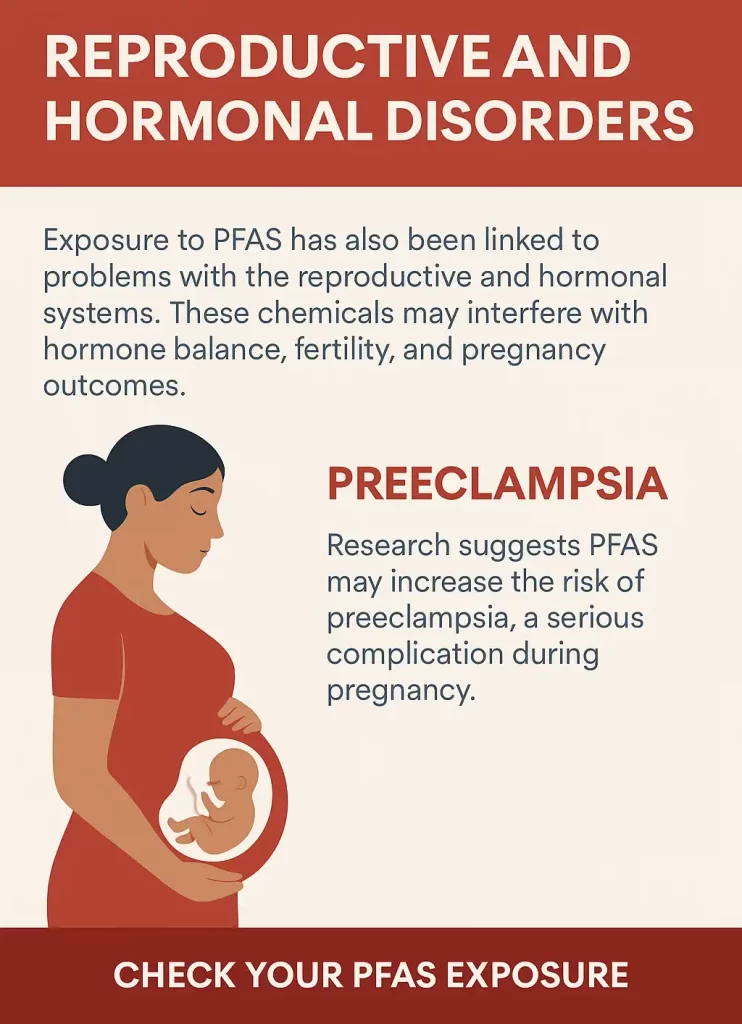
Long-Term Effects on the Immune System
Long-term exposure to PFAS can really take a toll on our body’s natural defenses. Research indicates that these chemicals might dampen the immune system’s ability to fight off infections, respond to vaccines, and tackle other health challenges. As a result, individuals who have been exposed to PFAS over time could find themselves getting sick more frequently or taking longer to bounce back.
There’s also growing concern that PFAS might contribute to autoimmune disorders, where the body mistakenly attacks its own healthy cells. While research is still underway, early findings hint that even low levels of PFAS could disrupt immune function, raising serious public health alarms for the future.
“Even low-level PFAS exposure may weaken the immune system and raise the risk of chronic illness—putting long-term health on the line.”
PFAS Lawsuit Overview
The growing number of PFAS claims across the country has led to a wave of PFAS litigation, as individuals, communities, and municipalities seek justice for the harm caused by these toxic chemicals. At the center of a PFAS case is the argument that companies knowingly polluted the environment and failed to warn the public. This has led to a surge in both individual lawsuits and large-scale actions like the PFAS class action lawsuit, where groups of victims join forces to take legal action.
Many of these PFAS class actions are built on the principle of strict liability, meaning companies can be held responsible for damage even without proving intent. These cases aim not only to secure compensation but also to support broader efforts around environmental protection. As more PFAS cases move through the courts, the legal system continues to shape how future PFAS litigation will be handled.
What the Lawsuits Claim About PFAS Manufacturers
Lawsuits against PFAS manufacturers claim that these companies knew the dangers of PFAS but continued to make and sell them anyway. Major chemical manufacturers like 3M and DuPont are accused of having produced PFAS for decades, despite early signs that these substances could cause serious harm to people and the environment.
The legal arguments often focus on the manufacturing process, which allowed PFAS to leak into local water supplies, soil, and air. These PFAS water contamination lawsuits aim to hold companies accountable for the damage caused, with growing pressure around PFAS liability for cleanup costs, health problems, and long-term environmental impacts.
Evidence Showing Companies Knew the Risks
One of the most serious allegations in PFAS lawsuits is that companies were aware of the dangers posed by these chemicals long before the public caught on. Internal documents, some dating back several decades, indicate that certain manufacturers knew PFAS could accumulate in the human body and lead to health issues—even with minimal exposure.
Yet, many of these companies kept producing and selling products containing PFAS without alerting consumers or regulators. In some instances, studies funded by the companies themselves revealed early signs of toxicity, but those findings were kept under wraps. This concealed knowledge has become a crucial element in the ongoing legal battle to hold these corporations accountable.
Key Defendants: 3M, DuPont, Chemours, and Others
Several big-name companies are currently facing lawsuits over PFAS, with 3M, DuPont, and Chemours leading the pack. These firms are being accused of producing and distributing PFAS chemicals for decades, even though there’s clear evidence that these substances can pose serious risks to human health and pollute our environment.
3M was one of the first companies to manufacture PFAS and has been hit with numerous lawsuits regarding its role in water contamination and the associated health risks. DuPont, along with its spin-off Chemours, has kept using PFAS in a variety of products, such as nonstick coatings and industrial materials.
As new evidence comes to light, other chemical companies are also being dragged into the fray, increasing the legal challenges facing the industry.
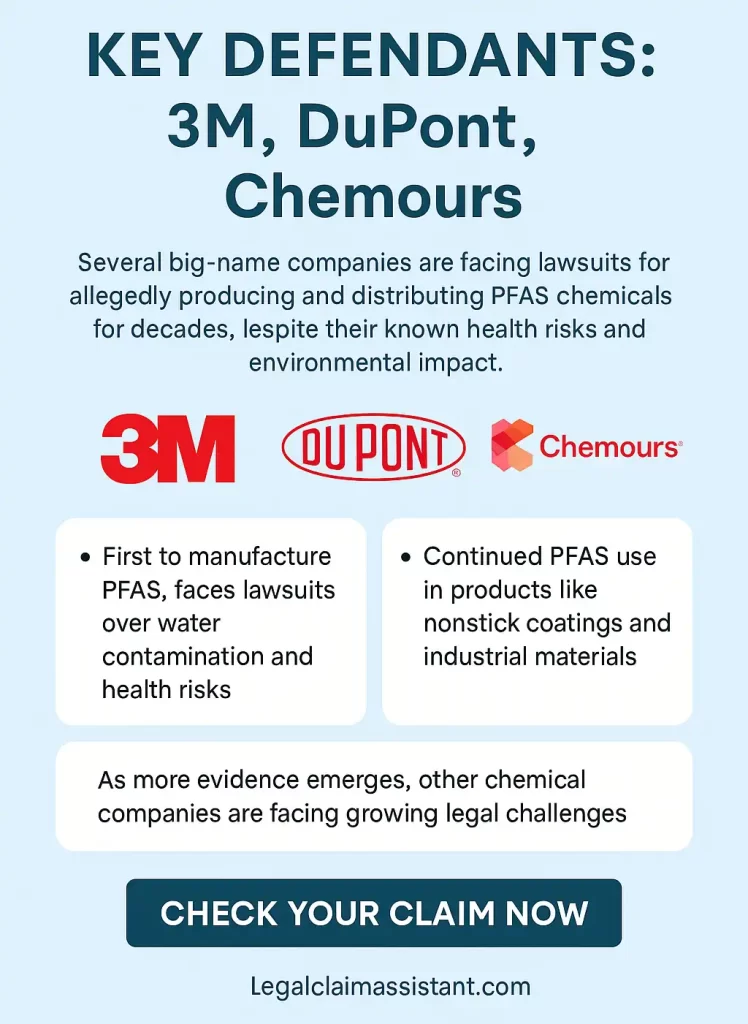
Differences Between Class Action and Individual PFAS Lawsuits
When it comes to PFAS lawsuits, there are two main legal paths: class action lawsuits and individual lawsuits. In a class action, a group of people with similar injuries caused by PFAS exposure file one case together. This often takes place in a federal court or district court, and can be more efficient for handling widespread harm.
Individual lawsuits, on the other hand, are filed by a single person or family. These can lead to higher compensation, especially when health effects are severe. Many of these cases are now part of a large federal lawsuit in the Sixth Circuit Court and other federal courts. The right path depends on your situation, evidence, and type of PFAS exposure.
PFAS Multidistrict Litigation (MDL) Explained
The PFAS class action lawsuit has ballooned to such an extent that numerous individual and group cases have been merged into what’s known as Multidistrict Litigation, or MDL. This legal approach is utilized when a bunch of lawsuits across the nation share similar details—like allegations that PFAS has led to health issues or tainted water supplies.
Rather than tackling each case individually in various courts, the MDL consolidates them into one federal court, making the whole process more efficient. This setup aids in collecting evidence, hearing expert testimonies, and pushing the overall litigation forward more smoothly. The PFAS MDL stands as one of the largest environmental cases in U.S. history.
“The PFAS MDL brings together hundreds of similar cases into one powerful legal effort—streamlining justice for communities harmed by toxic contamination.”
What Is the PFAS MDL and Why It Matters
The PFAS MDL, which stands for Multidistrict Litigation, is a way to consolidate hundreds of lawsuits from all over the country into a single, coordinated legal process. These lawsuits generally argue that exposure to PFAS—often through contaminated water—has led to serious health issues or environmental harm.
So, why is the PFAS MDL important? It streamlines the court system by allowing similar cases to be handled together. Instead of going through the same procedures in various courts, everything is managed in one location. This can result in quicker decisions, more uniform rulings, and potentially significant settlements. For those affected, the MDL provides a more straightforward route to seek justice and compensation.
AFFF Lawsuits and Military Base Exposure
Many of the most significant PFAS lawsuits center around a PFAS containing Firefighting foam, commonly referred to as aqueous film forming foam (AFFF). This foam has been a staple on military bases, at airports, and in fire departments for many years. Unfortunately, its widespread use has resulted in the contamination of soil, groundwater, and even municipal wastewater systems.
Veterans, firefighters, and local residents have come forward with claims, highlighting the long-term exposure and serious health issues they’ve faced. An increasing number of plaintiffs are joining a PFAS class action lawsuit against the military, seeking compensation for illnesses linked to AFFF. In these cases, military records often serve as crucial evidence, helping to establish where and when exposure took place—an essential factor in any Firefighting foam lawsuit.
How the MDL Differs from Other Legal Options
The PFAS MDL (Multidistrict Litigation) stands out from other legal avenues because it brings together numerous similar cases into a single federal court, rather than tackling each lawsuit one by one. This approach not only accelerates the process but also cuts down on costs and helps prevent conflicting decisions.
In an MDL, each plaintiff retains their individual case, which is different from a class action where everyone is grouped together under one outcome. This means that individuals can still seek compensation tailored to their specific injuries or exposure.
For those affected by PFAS, the MDL provides a more structured and effective way to hold companies accountable—without sacrificing the right to a personal resolution.
Recent Developments in the PFAS MDL
Lately, there have been some significant updates in the PFAS litigation, particularly in the ongoing multidistrict litigation (MDL). New cases keep popping up as more communities find PFAS contamination in their water or surroundings. Judges are giving the green light to new discovery requests, which is bringing us closer to possible settlements.
At the same time, there’s a growing focus on PFAS cleanup efforts, as plaintiffs are advocating not just for compensation but also for the restoration of contaminated sites. These developments highlight the broader aim of the MDL: to hold companies accountable while tackling the long-term effects of PFAS on health, water systems, and public safety.
“The PFAS MDL isn’t just about compensation—it’s about cleanup, accountability, and protecting public health for the long run.”
Who Qualifies to File a PFAS Lawsuit
If you’ve been affected by PFAS exposure, you might have the chance to file a lawsuit, particularly if you lived or worked in areas with contaminated water. This is especially true for Connecticut residents, where several locations have reported PFAS in the drinking water.
Those who have developed serious health issues—like cancer, ulcerative colitis, or reproductive problems—after prolonged exposure may be entitled to compensation. In class action lawsuits, a lead plaintiff is typically selected to represent the larger group and help push the case forward. If PFAS has impacted your life, it’s crucial to understand your rights and see if you qualify to join a case.
Health Conditions Linked to PFAS Exposure
PFAS exposure has been linked to a range of serious health conditions. Some of the most studied include kidney cancer, testicular cancer, and ulcerative colitis. Researchers have also found possible connections between PFAS and high cholesterol, thyroid disease, liver damage, immune system suppression, and complications during pregnancy like preeclampsia.
The risk often increases with long-term exposure, especially through contaminated drinking water. Because PFAS build up in the body over time, even low-level contact can lead to lasting harm. New studies continue to uncover additional health effects, making PFAS a growing concern for doctors, researchers, and public health agencies.
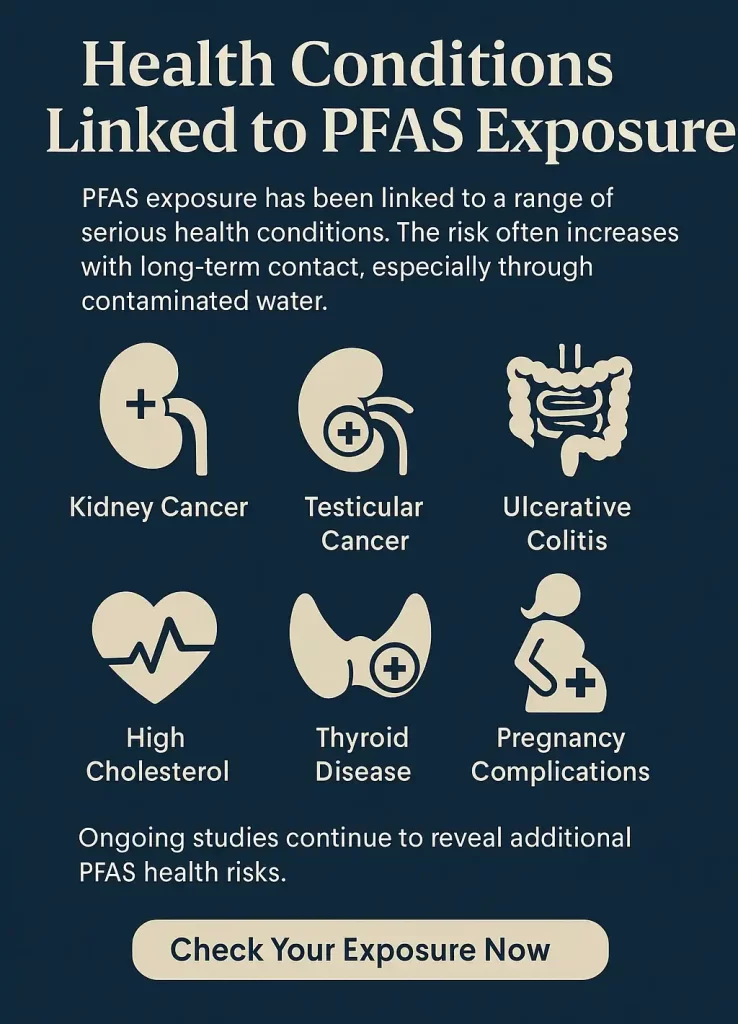
Military, Industrial, and Municipal Exposure Zones
It’s surprising how many people have been unknowingly exposed to PFAS, often just because of their living or working environments. Places like military bases, industrial sites, and municipal water systems have been pinpointed as significant sources of contamination. Veterans, in particular, might have encountered PFAS through firefighting foam or the drinking water on base. In these situations, military records can serve as proof of exposure.
Additionally, workers in manufacturing or waste treatment could be eligible for claims, especially if their job history includes time spent at known PFAS sites. Legislation such as The Veterans Exposed to Toxic PFAS Act is designed to assist those affected during their military service by enhancing access to care and compensation.
Zip Codes With Confirmed PFAS Water Contamination
PFAS contamination isn’t just a localized issue—it’s impacting communities all over the country. Thanks to ongoing testing, more cities and towns are uncovering PFAS in their local water supplies. Continuous monitoring efforts are crucial for pinpointing new contamination areas and assessing exposure risks across different zip codes, providing residents with vital information about their health and safety.
We also have a PFAS water contamination map that can help you find out if your area has been affected. This tool can be invaluable for supporting legal claims, assisting you to address PFAS contamination in your home or community, and understanding your potential exposure.
“From military bases to municipal tap water, PFAS exposure has quietly reached communities nationwide—your zip code could be one of them.”
Wrongful Death and Survivor Claims
When exposure to PFAS leads to the tragic loss of a loved one, families might have the option to file a wrongful death claim. These lawsuits are designed to hold companies responsible for the role their chemicals played in causing serious illnesses, such as cancer or organ failure.
Additionally, survivor claims could be relevant, allowing family members to seek compensation for the pain and suffering their loved one endured before passing away, as well as for lost wages and medical expenses. These legal avenues are often part of larger PFAS litigation and can offer financial relief to those left behind, all while advocating for justice in situations of preventable harm.
What Evidence You Need to File a Claim
To file a PFAS claim, you’ll need clear evidence showing how and when you were exposed—and how it affected your health. This often starts with medical records and diagnosis dates that link your condition to possible PFAS exposure. If you’ve been part of a medical monitoring program, those results can also support your case.
You may also need documents like water bills, military records, or work history to prove where exposure happened. A detailed timeline and clear exposure duration help strengthen your claim. In some cases, results from a certified PFAS testing lab may also be useful to confirm contamination.
Medical Records and Diagnosis Dates
When you’re thinking about filing a PFAS lawsuit, your medical records and the dates of your diagnoses are crucial pieces of evidence. They help establish that you developed a health issue that might be linked to PFAS exposure, and they pinpoint when that issue started. This timeline is especially important in cases involving serious conditions like cancer, ulcerative colitis, or pregnancy complications such as preeclampsia.
Having accurate medical documentation is essential as it helps tie your illness to the time you were exposed to PFAS, whether that was at home, work, or during military service. If you’re considering taking legal action, gathering your full medical history and confirming the exact dates of your diagnoses is a smart first step.
Proof of Residence in a Contaminated Area
To file a PFAS claim, you need to demonstrate that you lived or worked in an area affected by contamination during your exposure. This is known as proof of residence, and it plays a crucial role in linking your health issues to a specific source of PFAS.
You might find useful documents like rental agreements, utility bills, mortgage statements, or any official mail that shows your address. If your exposure occurred on a military base or through your job, military records or your work history can also bolster your case. Establishing a connection between your location and known PFAS contamination is a vital step in proving your eligibility for compensation.
“Your medical records and proof of residence are the foundation of a strong PFAS claim—linking where you were, when you were exposed, and how it affected your health.”
Water Bills, Military Records, or Work History
To back up your PFAS claim, you’ll need some key documents that highlight where and how you were exposed. For instance, water bills can show that you lived in an area known for PFAS contamination. Military records can help demonstrate the time you spent on bases where PFAS-laden firefighting foam was used. Additionally, your work history can provide evidence of employment at industrial sites or facilities where exposure might have happened. All these records play a crucial role in linking your personal experience to the broader issue of PFAS contamination.
Exposure Duration and Timeline
When it comes to exposure duration and timeline, the specifics really count. Courts often pay close attention to how long you were exposed—whether it was months or years—and how that timeframe relates to your medical history. Having a clear timeline that outlines where you lived or worked, when your symptoms started, and when you received a diagnosis can significantly bolster your case. This detailed perspective helps both lawyers and judges grasp the connection between your exposure and your health condition.

How Much Compensation Can Victims Receive?
If you’ve been affected by PFAS exposure, you might be curious about the compensation you could potentially receive. The amount can vary based on a few key factors—like your health status, the duration of your exposure, and the strength of your evidence.
In lawsuits related to PFAS exposure, those who have developed serious illnesses, such as cancer, often see higher compensation amounts. This compensation can help cover medical expenses, lost wages, pain and suffering, and sometimes even future medical care. Every situation is unique, but looking at what others have received can give you a better idea of what to expect.
Settlement Estimates Per Person (Based on Lawsuit Type)
When it comes to PFAS lawsuits, the average PFAS settlement amounts for individuals can vary quite a bit, typically falling between $75,000 and $500,000. This range largely depends on the specifics of the case and the extent of the harm suffered. Those who have been confirmed to have been exposed and are dealing with serious health issues, such as kidney cancer or testicular cancer, usually find themselves at the higher end of that spectrum.
These settlement figures are meant to assist victims in recovering from the damaging effects of toxic PFAS chemicals found in their water, workplaces, or everyday products. If you have medical records and evidence of your exposure, you might be eligible for compensation through either a personal lawsuit or a class action settlement.
“PFAS settlements can range from $75,000 to $500,000 per person, depending on exposure, health impact, and lawsuit type.”
Factors That Influence Claim Value
The value of a PFAS claim depends on several personal and legal factors. Courts look at how long you were exposed, the level of PFAS in your environment, and whether you developed a serious health condition like cancer or ulcerative colitis. Your ability to work, the cost of medical treatment, and the strength of your documentation—such as diagnosis records or proof of residence in a contaminated area—can also play a role. Each case is unique, so the payout varies from person to person.
Key factors:
Severity of health condition
Duration and level of exposure
Type of PFAS (e.g., PFOA, PFOS)
Quality of supporting evidence
Impact on work and daily life
What Costs Are Covered: Medical Bills, Pain, Lost Income
PFAS lawsuit settlements are meant to help victims recover both financially and emotionally. Compensation often covers past and future medical bills related to PFAS-linked illnesses, including cancer treatments, specialist visits, and ongoing monitoring. Victims may also receive payment for pain and suffering, which includes emotional distress and the impact of chronic illness on daily life. If PFAS exposure forced you to miss work or stop working altogether, lost income and reduced earning capacity can also be included in the final settlement amount.
PFAS Lawsuits in Your State
PFAS contamination is a pressing issue that impacts communities all over the U.S., and we’re seeing a rise in legal actions at the state level. Each state is taking its own unique approach to tackle PFAS, whether that means regulating it or holding those responsible accountable. Some states have already kicked off major lawsuits, while others are still in the process of investigating or rolling out cleanup plans.
If you’re in a state affected by PFAS, you might have some legal options available, depending on how your local government is handling the situation. Many states are also tapping into funding from resource conservation programs and federal infrastructure laws to aid in cleaning up PFAS and providing support to those impacted.
State-by-State Status of PFAS Litigation
South Carolina
Several PFAS cases have been filed in federal court, and the state is actively involved in the nationwide multidistrict litigation (MDL). South Carolina has also pushed for more transparency from chemical companies operating in the region.Ohio
Ohio is one of the leading states in PFAS litigation and monitoring. The state has launched lawsuits against chemical manufacturers and continues to investigate contamination in both rural and urban areas.Pennsylvania
Pennsylvania has numerous contamination sites, particularly near military bases. The state is pursuing legal action and has introduced strict PFAS limits for public water systems.Illinois
Illinois has filed lawsuits against multiple companies tied to PFAS pollution and is enhancing state-level monitoring and testing. Recent efforts focus on preventing further contamination through wastewater treatment systems.California
California is taking a strong regulatory stance with some of the toughest PFAS limits in the country. The state is involved in several lawsuits and is investing heavily in filtration systems and public health protections.New York
New York has been active in suing chemical manufacturers and securing funds for cleanup. The state also maintains a robust PFAS testing program and continues to expand support for residents affected by contaminated water supplies.
“From South Carolina to California, states are stepping up with lawsuits, regulations, and cleanup efforts—your zip code could be next.”
How to Get a PFAS Lawyer
If you think you’ve been affected by PFAS exposure, reaching out to a qualified PFAS lawyer is a crucial first step. These cases can get pretty complicated, involving intricate science, medical evidence, and legal strategies—so it’s essential to find someone who really knows their stuff. A knowledgeable PFAS water contamination lawyer can help you figure out if you’re eligible to file a claim and will guide you through every step of the process, from collecting necessary documents to negotiating a settlement.
Many PFAS lawyers provide free consultations and work on a contingency basis, which means you won’t owe them anything unless they win your case.
Why You Need a Lawyer Experienced in PFAS Litigation
A seasoned PFAS lawyer knows how to craft a solid case by digging into exposure history, medical records, and relevant legal precedents. These lawsuits typically take on big chemical companies that have deep pockets and extensive legal teams, so having an attorney who understands the ins and outs of PFAS cases—especially in federal court or multidistrict litigation—can really tip the scales in your favor. They’ll be well-versed in what evidence to gather, how to assess your damages, and how to maneuver through the intricate world of settlements. Without proper legal support, it’s all too easy to overlook crucial deadlines or underestimate the value of your claim.
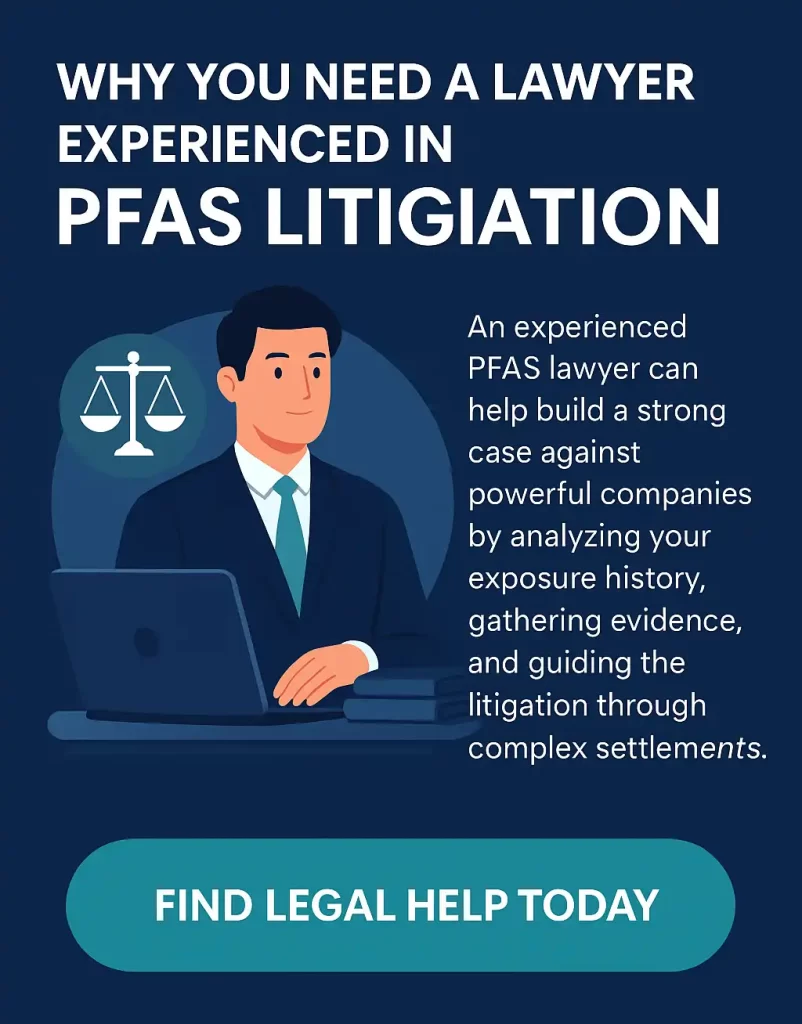
What to Expect from the Legal Process
When you work with PFAS attorneys, the journey typically kicks off with a complimentary case review. If you meet the criteria, your lawyer will start gathering essential evidence—like medical records, proof of where you live, and your work or military background. They’ll file your claim and might even include it in a broader PFAS class action or multidistrict litigation. Most cases go through a fact-finding phase known as discovery, followed by discussions about settlements or court proceedings. While the process can take some time, your attorney will take care of all the legal intricacies and keep you updated every step of the way.
No Upfront Costs and Free Consultation
When you work with PFAS attorneys, the journey typically kicks off with a complimentary case review. If you meet the criteria, your lawyer will start gathering essential evidence—like medical records, proof of where you live, and your work or military background. They’ll file your claim and might even include it in a broader PFAS class action or multidistrict litigation. Most cases go through a fact-finding phase known as discovery, followed by discussions about settlements or court proceedings. While the process can take some time, your attorney will take care of all the legal intricacies and keep you updated every step of the way.
How to File in Less Than 3 Minutes
Filing a PFAS claim is quick and straightforward. With our online intake process, you can answer a few simple questions about your exposure, health, and location. In under three minutes, you’ll find out if you might qualify. After that, a legal team will reach out to go over your details and help you take the next steps. No paperwork, no hassle—just a fast way to kick off your claim and get the support you need.
“Most PFAS claims begin with a free case review—and from that point on, your attorney handles the legal process for you, from evidence gathering to possible settlement.”
Frequently Asked Questions
PFAS lawsuits can be pretty complicated, and it’s totally normal to have questions—especially if you’re just starting to learn about your exposure or looking into your legal options. Below, we’ve tackled some of the most common concerns people have about PFAS, the health risks involved, and how to get involved in the ongoing lawsuits. We’ve kept the answers straightforward to help you make informed choices.
What are PFAS and where do they come from?
PFAS (per- and polyfluoroalkyl substances) are synthetic chemicals found in thousands of products, like nonstick cookware, firefighting foam, food packaging, and waterproof clothing. They’ve been around since the 1940s and are notorious for their durability—hence the nickname “forever chemicals.” PFAS can seep into water, soil, and even the air, making them tough to avoid.
How much exposure is considered harmful?
There’s no “safe” level of PFAS exposure, but research indicates that even small amounts over time can heighten the risk of health issues. The EPA has established strict limits for PFAS in drinking water because these chemicals accumulate in the body and don’t break down easily. Long-term exposure is particularly concerning for individuals with weakened immune systems or pre-existing health conditions.
Can I file if I was exposed years ago?
Absolutely. You can still file a PFAS claim even if your exposure occurred many years back. What’s most important is whether you were exposed to contaminated water, air, or products—and if you developed a related health issue. Many PFAS-related illnesses can take time to manifest, so your diagnosis doesn’t need to be recent for you to qualify.
Can I join the lawsuit if I already have a lawyer?
If you’re already working with a lawyer on a PFAS case, you probably can’t join another lawsuit without changing your legal representation. However, you can always seek a second opinion or reach out to us to explore your options. We’ll help you understand what’s possible based on your current legal situation.
Do I need to have cancer to qualify for a PFAS lawsuit?
Not necessarily. If you’ve been diagnosed with kidney cancer, testicular cancer, or ulcerative colitis, you might be eligible for a PFAS lawsuit—even if your exposure occurred years ago. These three health conditions are currently the main ones associated with PFAS claims in ongoing lawsuits. While other health issues are still being looked into, right now, only those with one of these confirmed diagnoses and a history of PFAS exposure can file a claim.
Take Action Today
If you’ve been exposed to PFAS and diagnosed with kidney cancer, testicular cancer, or ulcerative colitis, now is the time to act. Lawsuits are moving forward, settlements are being finalized, and deadlines may limit how long you have to file. Don’t wait and risk missing your chance for compensation.
Check If You Qualify for the PFAS Lawsuit
Start your free case review in less than 3 minutes.
No fees. No obligation. Just answers.
Time is limited—new settlements are moving quickly. See if you qualify today and protect your rights before it’s too late.
Related Article

What Philips CPAP Machines Are Recalled and Why


